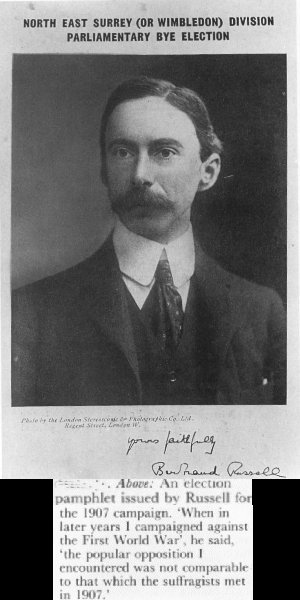私は1907年(注:添付写真は1907年の、35歳のラッセル=髭を
はやしていた時)に英国哲学会(注:the Aristotelian Society アリストテレスについて研究する学会ではない。因みに、みすず書房版の訳書で野田又夫氏は「アリストテレス学会」と訳出)で私が読み上げた論文 -それはハロルド・ヨアキムの著書『真理の本性』(The Nature of Truth)を扱ったものであった(注:ヨアヒムとの表記あり)ー の一部をここに引用することによって、この問題の重要性をおそらく最もよく例示することができると思う。 我々が今まで考察してきた学説は全て一つの論理説(論理学上の学説)から演繹可能であり、その中心的な学説は次のように言いあらわしてよいだろう。(訳注:以下は最後まで、ラッセルの考えではなく、ラッセルが攻撃しようとする一元論的観点の説明であることに注意): (即ち)「あらゆる関係は、関係づけられた諸項の本性によって基礎づけられている。」 これを内面的関係の公理と呼ぶことにしよう。この公理からただちに、実在あるいは真理の全体はヨアキム氏の言う意味で「有意義な全体( a significant whole)」でなければならない、ということが帰結する(It follows ~ that)。というのは、個々の部分(各部分)は、他の部分の全て及び全体に対して、それのもつ関係を明示する(exhibits 開陳する)ところの性質持っているからである。従って、どれか一つの部分の本性(性質)が完全に知られているならば、全体及び他のすべての部分との本性(性質)もまたそれに完全に知られるであろう(ということになる)。逆に,全体の本性(性質)が完全に知られているならば、全体の各部分に対する関係、従ってまた、各部分が他の個々の部分に対してもつ関係、従ってまた、各部分の本性(性質)も、それに含まれていなければならない(知られていなければならない)。実在または真理がヨアキム氏のいう意味での有意義な全体であるならば、内面的関係の公理が真でなければならないということも、明白である。こうして上記の公理は、真理についての一元論的理論と等値である。 さらにまた、我々が一つの「もの」(a thing)とその「本性」(性質)とを区別すべきでないと仮定するならば、上記の公理から、いかなるものも全体への関係なしには十分に真実なやり方で考察することはできない、ということになる(という結論が出てくる)。なぜなら、「AはBに関係している」ということを我々が考える場合、そのAとBはまた、他の全てのものに関係しているのであり、従ってAとBが何であるかを言うためには、宇宙における他の全てのものに言及する必要があるからである。もし我々Aの本性のうち、それによってAがBに関係づけられる部分のみを考察するならば、我々はBに関係するものとしてのA(A qua related to B)を考察している.と言える。けれどもこれ、Aを考察する、抽象的なかつ部分的にのみ真な方法である。なぜなら、AそのものであるところのAの本性(性質)は、Bに対すると共に他の全てのものに対する関係の基礎を含んでいるからである。こうして,全宇宙を考慮に入れなければ、十分な意味で真な何ごともAについて言うことができない。そしてそうなると、Aについて言われることは、他のいかなるものについて言われることと同じものになるであろう。それは、相異なるものの本性(性質)は、ライプニッツの単子の本性(性質)と同様に、すべて同一の「関係の体系」を表現せざるをえないからである。 (訳注:以上はこれから批判しようとしている「内的関係説」の立場の説明です!。)
Chapter 5: Revolt into Pluralism, n.2
I think perhaps I can best illustrate the importance of this question by quoting part of a paper that I read to the Aristotelian Society in 1907 , which deals with Harold Joachim’s book on The Nature of Truth. The doctrines we have been considering may all be deduced from one central logical doctrine, which may be expressed thus: ‘Every relation is grounded in the natures of the related terms.’ Let us call this the axiom of internal relations. It follows at once from this axiom that the whole of reality or of truth must be a significant whole in Mr Joachim’s sense. For each part will have a nature which exhibits its relations to every other part and to the whole; hence, if the nature of any one part were completely known, the nature of the whole and of every other part would also be completely known; while conversely, if the nature of the whole were completely known, that would involve knowledge of its relations to each part, and therefore of the relations of each part to each other part, and therefore of the nature of each part. It is also evident that, if reality or truth is a significant whole in Mr Joachim’s sense, the axiom of internal relations must be true. Hence the axiom is equivalent to the monistic theory of truth. Further, assuming that we are not to distinguish between a thing and its ‘nature’, it follows from the axiom that nothing can be considered quite truly except in relation to the whole. For if we consider ‘A is related to B’, the A and the B are also related to everything else, and to say what the A and the B are would involve referring to everything else in the universe. When we consider merely that part of A’s nature in virtue of which A is related to B, we are said to be considering A qua related to B; but this is an abstract and only partially true way of considering A, for A’s nature, which is the same thing as A, contains the grounds of its relations to everything else as well as to B. Thus nothing quite true can be said about A short of taking account of the whole universe; and then what is said about A will be the same as what would be said about anything else, since the natures of different things must, like those of Leibniz’s monads, all express the same system of relations.
Source: My Philosophical Development, chap. 5:1959.
More info.:https://russell-j.com/beginner/BR_MPD_05-020.HTM

